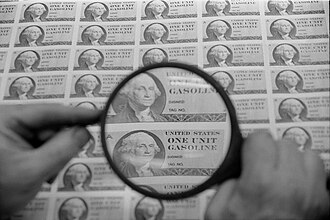1973 oil crisis
| Advanced search |
- About 3 results found and you can help!
 Gasoline ration stamps printed by the Bureau of Engraving and Printing in 1974 |
The 1973 oil crisis started in October 1973, when the members of Organization of Arab Petroleum Exporting Countries or the OAPEC (consisting of the Arab members of OPEC, plus Egypt, Syria and Tunisia) proclaimed an oil embargo. This was in response to the U.S. decision to re-supply the Israeli military during the Yom Kippur war. It lasted until March 1974. With the U.S. actions seen as initiating the oil embargo and the long term possibility of high oil prices, disrupted supply, and recession, a strong rift was created within NATO. Additionally, some European nations and Japan sought to disassociate themselves from the U.S. Middle East policy. Arab oil producers had also linked the end of the embargo with successful U.S. efforts to create peace in the Middle East, which complicated the situation. To address these developments, the Nixon Administration began parallel negotiations with both Arab oil producers to end the embargo, and with Egypt, Syria, and Israel to arrange an Israeli pull back from the Sinai and the Golan Heights after the fighting stopped. By January 18, 1974, Secretary of State Henry Kissinger had negotiated an Israeli troop withdrawal from parts of the Sinai. The promise of a negotiated settlement between Israel and Syria was sufficient to convince Arab oil producers to lift the embargo in March 1974. By May, Israel agreed to withdraw from some parts of the Golan Heights.
- Related: Hubbert peak theory, Supply shock, 1967 Oil Embargo, 1970s Energy Crisis, 1990 spike in the price of oil, 2000s (decade) energy crisis
| Saudi dove in the oil slick Saudi dove in the oil slick observer.guardian.co.uk/business/story/0,6903,421888,00.html - Web |
| EIA presentation: 25th Anniversary of the 1973 Oil... EIA presentation: 25th Anniversary of the 1973 Oil Embargo www.eia.doe.gov/emeu/25opec/anniversary.html - Web |
| 35 Years After the Arab Oil Embargo 35 Years After the Arab Oil Embargo www.ensec.org/.../index.php?option=com_content&view=article&id=155:35yearsafterthearaboilembargo&catid=83:middle-east&Itemid=324 - Web |
Gallery for «1973 oil crisis»
Average relevance
